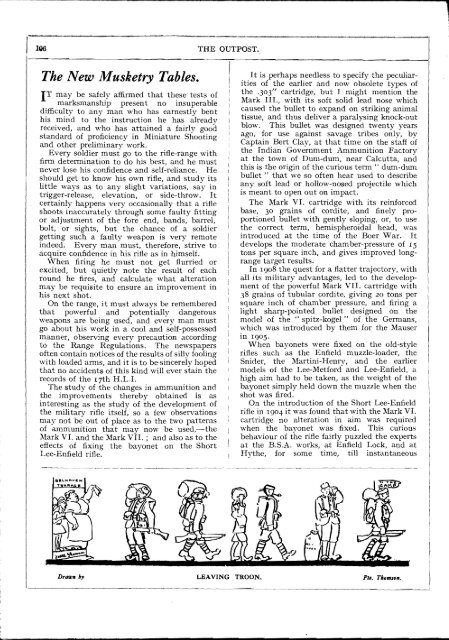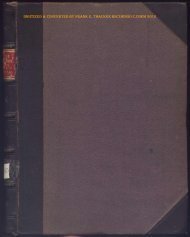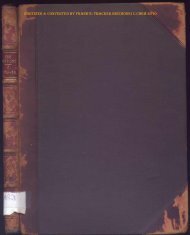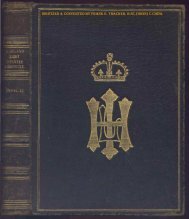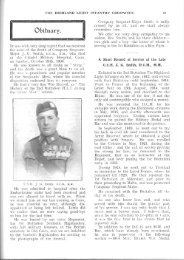The Outpost Vol 1 - The Royal Highland Fusiliers
The Outpost Vol 1 - The Royal Highland Fusiliers
The Outpost Vol 1 - The Royal Highland Fusiliers
Create successful ePaper yourself
Turn your PDF publications into a flip-book with our unique Google optimized e-Paper software.
106 THE OUTPOST.<br />
<strong>The</strong> New Musketry Tables.<br />
IT may be safely affirmed that these tests of<br />
marksmanship present no insuperable<br />
difficulty to any man who has earnestly bent<br />
his mind to the instruction he has already<br />
received, and who has attained a fairly good<br />
standard of proficiency in Miniature Shooting<br />
and other preliminary work.<br />
Every soldier must go to the rifle-range with<br />
firm detemlination to do his best, and he must<br />
never lose his confidence and self-reliance. He<br />
should get to know his own rifle, and study its<br />
little ways as to any slight variations, say in<br />
trigger-release, elevation, or side-throw. It<br />
certainly happens very occasionally that a rifle<br />
shoots inaccurately through some faulty fitting<br />
or adjustment of the fore end, bands, barrel,<br />
bolt, or sights, but the chance of a soldier<br />
getting such a fau1ty weapon is very remote<br />
indeed. Every man must, therefore, strive to<br />
acquire confidence in his rifle as in himself.<br />
\Vhen firing he must not get flurried or<br />
excited, but quietly note the result of each<br />
round he fires, and calculate what alteration<br />
may be requisite to ensure an improvement in<br />
his next shot.<br />
On the range, it must always be remembered<br />
that powerful and potentially dangerous<br />
weapons are being used, and every man must<br />
go about his work in a cool and self-possessed<br />
manner, observing every precaution according<br />
to the Range Regulations. <strong>The</strong> newspapers<br />
often contain notices of the results of silly fooling<br />
with loaded amlS, and it is to be-sincerely hoped<br />
that no accidents of fuis kind will ever stain the<br />
records of the 17th H.L.I.<br />
<strong>The</strong> study of the changes in ammunition and<br />
the improvements thereby obtained is as<br />
interesting as the study of the development of<br />
the military rifle itself, so a few observations<br />
may not be out of place as to the two patterns<br />
of ammunition that may now be used,-the<br />
Mark VI. and the Mark VII.; and also as to the<br />
effects of fixing the bayonet on the Short<br />
Lee-Enfield rifle.<br />
It is perhaps needless to specify the peculiarities<br />
of the earlier and now obsolete types of<br />
the .303" cartridge, but I might mention the<br />
Mark Ill., with its soft solid lead nose which<br />
caused the bullet to expand on striking animal<br />
tissue, and thus deliver a paralysing knock-out<br />
blow. This bullet was designed twenty years<br />
ago, for use against savage tribes only, by<br />
Captain Bert Clay, at that time on the staff of<br />
the Indian Government Ammunition Factory<br />
at the town of Dum-dum, near Calcutta, and<br />
this is the origin of the curious term" dum·dum<br />
bullet" that we so often hear used to describe<br />
any soft lead or hollow-nosed projectile which<br />
is meant to open out on impact.<br />
<strong>The</strong> Mark VI. cartridge with its reinforced<br />
base, 30 grains of cordite, and finely proportioned<br />
bullet wifu gently sloping, or, to use<br />
the correct term, hemispheroidal head, was<br />
introduced at the time of the Boer War. It<br />
develops the moderate Chamber-pressure of IS<br />
tons per square inch, and gives improved longrange<br />
target results.<br />
In I908 the quest for a flatter trajectory, with<br />
all its military advantages, led to the development<br />
of the powerful Mark VII. cartridge with<br />
38 grains of tubular cordite, giving 20 tons per<br />
square inch of chamber pressure, and firing a<br />
light sharp-pointed bullet designed on the<br />
model of the " spitz-kogel" of the Germans,<br />
which was introduced by them for the Mauser<br />
in I905.<br />
\Vhen bayonets were fixed on the old-style<br />
rifles such as the Enfield muzzle-loader, the<br />
Snider, the Martini-Henry, and the earlier<br />
models of the Lee-Metford' and Lee-Enfield, a<br />
high aim had to be taken, as the weight of the<br />
bayonet simply held down the muzzle when the<br />
shot was fired.<br />
On the introduction of the Short Lee-Enfield<br />
rifle in I904 it was found that with the Mark VI.<br />
cartridge no alteration in aim was required<br />
when the bayonet was fixed. This curious<br />
behaviour of the rifle fairly puzzled the experts<br />
at the B.S.A. works, at Enfield Lock, and at<br />
Hyi:he, for some time, till instantaneous


